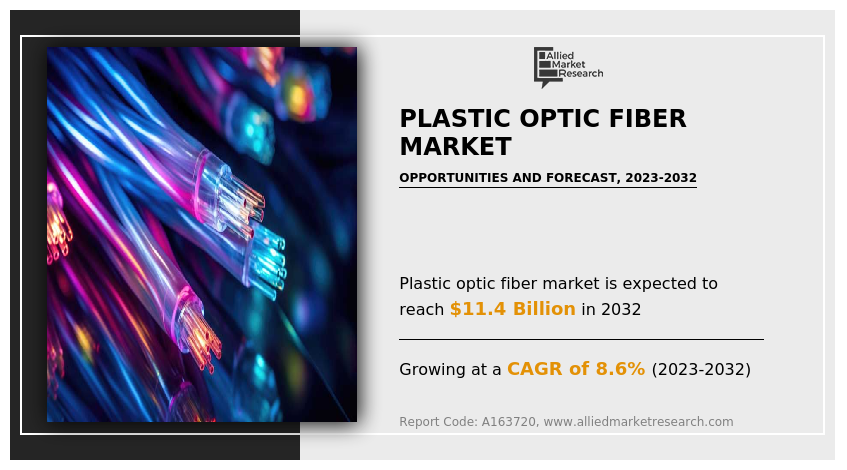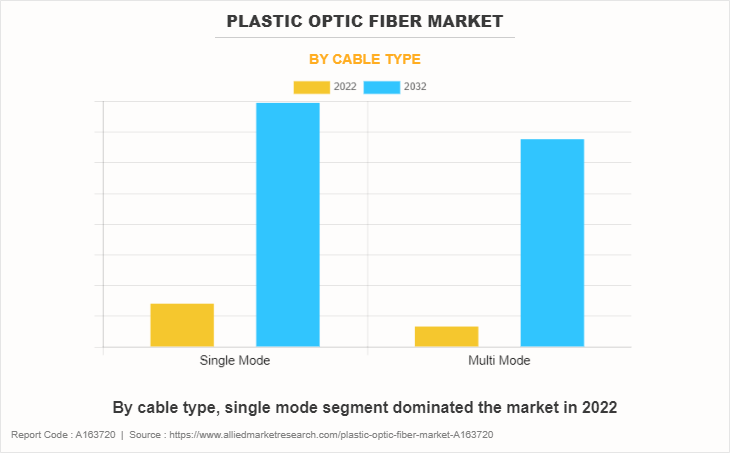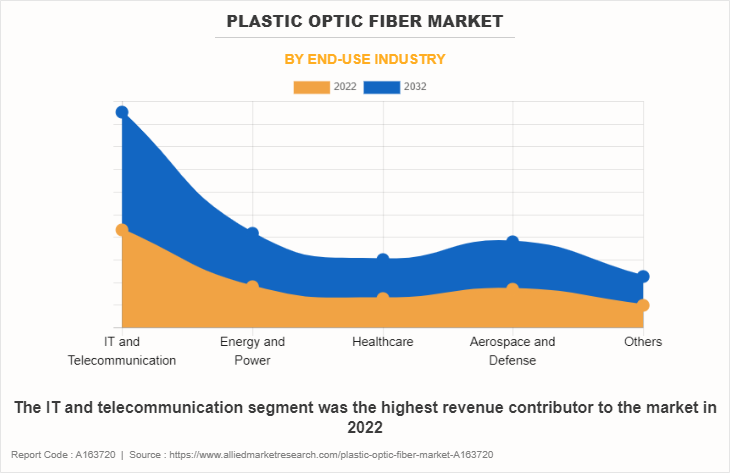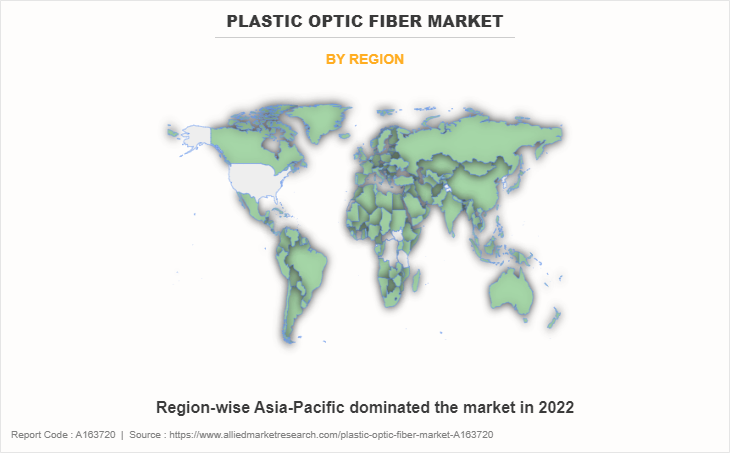Plastic Optic Fiber Market Research, 2032
The global plastic optic fiber market size was valued at $5.0 billion in 2022, and is projected to reach $11.4 billion by 2032, growing at a CAGR of 8.6% from 2023 to 2032.
Report Key Highlighters:
- The global plastic optic fiber market has been analyzed in terms of value ($Million). The report's analysis is provided based on cable type, end-user industry, four major regions, and over 15 countries.
- The global plastic optic fiber market report includes a detailed study covering underlying factors influencing the industry opportunities and trends.
- The plastic optic fiber market is fragmented in nature with few players such as Corning Incorporated, Finisar Corporation, Finolex Cables Ltd., Fujikura Ltd., Hengtong Group Co., Ltd., Leoni, PCT International, Inc, Prysmian Group, Sumitomo Electric Industries Ltd, and Yangtze Optical Fiber and Cable Joint Stock Limited Company.
- The report facilitates strategy planning and industry dynamics to enhance decision making for existing market players and new entrants entering the plastic optic fibers industry.
- Countries such as China, U.S., India, Germany, and Brazil hold a significant share in the global plastic optic fiber market.

Plastic optic fibers refer to a technology that transmits data, information, or signals using light pulses through flexible, transparent fibers that are made of polymers. These thin fibers facilitate the transmission of data over long distances at incredibly high speeds. The core principle of plastic optic fibers revolves around the transmission of light signals through total internal reflection.
The transmission of information through plastic optic fibers involves changing electrical signals into mild pulses using a transmitter, sending these pulses through the plastic optic fiber cables, and then reconverting them back into electrical signals at the receiving end. This process occurs rapidly and efficiently, allowing the transmission of massive quantities of information over long distances with minimal loss or degradation.
The continuous expansion and improvement of telecommunications infrastructure represents a significant driver for the growing demand for plastic optic fibers. This is primarily fueled by means of the ever-growing need for faster, extra reliable, and higher-capacity communication networks. The proliferation of high-speed internet, the creation of 5G technology, and the exponential growth of data traffic necessitate a resilient infrastructure capable of dealing with these demands. Plastic optic fibers provide the fundamental backbone for these networks, presenting immense bandwidth abilities that allow seamless information transmission, video streaming, cloud computing, and the burgeoning Internet of Things (IoT) ecosystem. All these factors drive the demand for the plastic optic fiber market during the forecast period.
However, installation and maintenance costs impede the widespread adoption and growth of optic fiber technology. Despite its undeniable advantages in data transmission speed, bandwidth, and reliability, the initial investment required for the deployment of plastic optic fiber networks remains substantial. The expenses encompass a range of factors such as the cost of the fiber itself, specialized equipment needed for installation, and skilled labor essential for handling and laying the intricate network. In addition, maintenance costs compound the financial burden. While plastic optic fibers are known for their durability, they are not immune to wear, tear, or external factors that degrade signal quality over time. All these factors hamper the plastic optic fiber market growth.
Advancements in technology and ongoing research continuously propel the opportunities and innovation within the realm of plastic optic fibers. These advancements open new perspectives across various industries and applications. Enhanced manufacturing techniques and material sciences enable the production of fibers with improved efficiency, lower signal loss, and increased bandwidth capacities. In addition, emerging technologies have fostered the creation of novel devices and components that augment the capabilities of plastic optic fiber systems. Advanced transmitters, receivers, amplifiers, and signal processing technologies optimize data transmission, enabling higher speeds and reliability over longer distances. All these factors are anticipated to offer new growth opportunities for the plastic optic fiber market during the forecast period.
The plastic optic fiber market is segmented on the basis of cable type, end-use industry, and region. On the basis of cable type, the market is divided into single mode and multi mode. On the basis of end-use industry, the market is segmented into IT & telecommunication, energy & power, healthcare, aerospace & defense, and others. Region-wise, the market is analyzed across North America, Europe, Asia-Pacific, and LAMEA.

Single mode cables offer higher bandwidth and allow for longer-distance data transmission without significant signal loss. This capability is crucial for various applications requiring high-speed and long-range data transfer such as telecommunications, data centers, and high-performance computing. In addition, the expansion and upgrade of telecommunications networks such as internet backbones and long-distance communication links, heavily rely on single-mode plastic optic fibers. The demand for faster and more reliable data transmission fuels the adoption of single-mode cables in these infrastructures.

The IT & telecommunication segment accounted for more than two-fifths of global plastic optic fiber market share in 2022 and is expected to maintain its dominance during the forecast period. Increase in growth in data consumption, particularly with high-definition content, cloud computing, and emerging technologies such as IoT and AI, there is a constant need for higher bandwidth and faster data transmission speeds. Optical fiber, with its ability to carry large amounts of data at incredible speeds, meets this demand effectively. In addition, the rollout of 5G technology demands an infrastructure capable of handling the increased speed and volume of data. Optical fibers form the backbone of these networks, enabling the rapid and reliable transmission of large data volumes required for 5G services.

Asia-Pacific accounted for more than half of global plastic optic fiber market share in 2022 and is expected to maintain its dominance during the forecast period. The rapid expansion of telecommunications infrastructure such as broadband networks and mobile services, across countries in the Asia-Pacific region is a significant driver for optical fiber. In addition, the surge in internet usage, driven by a growing population of tech-savvy individuals and businesses, is propelling the demand for faster and more reliable internet connections during the forecast period.
Key players in the global plastic optic fiber industry include Corning Incorporated, Finisar Corporation, Finolex Cables Ltd., Fujikura Ltd., Hengtong Group Co., Ltd., Leoni, PCT International, Inc, Prysmian Group, Sumitomo Electric Industries Ltd, and Yangtze Optical Fiber and Cable Joint Stock Limited Company.
Apart from these major players, there are other key players in the plastic optic fiber market. These include AFL, Asahi Kasei Corporation, Chromis Fiberoptics, Clearfield Inc., Electri-Cord Manufacturing Company, Molex, LLC, PolyOptics GmbH, Radix Technologies Ltd., SABIC, Teledyne Reynolds, Timbercon Europe Ltd., and VAHALI Group.
Historical Trends Of Plastic Optic Fiber:
- The concept of transmitting data via light through plastic optic fibers surfaced in the 1970s. Initial experiments and foundational research by companies and institutions such as Corning and Bell Labs established the groundwork for optical communication.
- The 1980s witnessed the commercial launch of plastic optic fiber systems. The technology rapidly replaced traditional copper cables due to its superior data transmission capabilities. Telecom companies began laying extensive plastic optic fiber networks, primarily for long-distance communication.
- The demand for high-speed data transmission surged in 1990. Plastic optic fibers played a pivotal role in this era, supporting the infrastructure for the burgeoning internet. Innovations in plastic optic fibers, including Dense Wavelength Division Multiplexing (DWDM), enabled greater data capacity over existing optical fibers.
- The 2000s marked the expansion of plastic optic fibers beyond telecommunications. It found applications in various sectors such as healthcare (medical imaging), military, data centers, and high-speed trading due to its reliability and high-bandwidth capabilities. Technological advancements focused on reducing signal loss and enhancing transmission speeds.
- Advancements in optical technologies, particularly in coherent optics and photonic integration, paved the way for ultra-high-speed data transmission in 2010. The demand for faster internet, streaming services, and cloud computing further propelled investments in plastic optic fiber infrastructure worldwide.
- The early 2020s witnessed a continuous push for innovation in plastic optic fiber technology. Efforts were directed toward enhancing efficiency, reducing latency, and developing more cost-effective manufacturing techniques. Smart integration and IoT capabilities within plastic optic fibers led to the development of intelligent networks capable of self-monitoring and adaptive functionalities.
Key Potential Factors That Drive The Plastic Optic Fiber Market Demand
In the global plastic optic fiber market, an increasing number of companies have adopted geographical expansion to expand the market or develop new products. For instance, in August 2022 Corning Incorporated announced a new optical cable manufacturing facility supported by AT&T and record industry broadband demand. It builds a new cable manufacturing facility in Gilbert, Arizona, located in the Greater Phoenix region which extends company strategic investments in optical fiber, cable, and connectivity solutions to meet record demand. Also in November 2021, Fujikura Ltd opened a new plastic optic fiber cable manufacturing facility in Swindon, UK. It is an ultra-high density outside plant cable designed specifically for fiber-to-the-home and access network applications. This new facility is the first factory located outside Japan to produce this type of plastic optic fiber cable within the Fujikura Group.
Key Benefits For Stakeholders
- This report provides a quantitative analysis of the market segments, current trends, estimations, and dynamics of the plastic optic fiber market analysis from 2022 to 2032 to identify the prevailing plastic optic fiber market opportunities.
- The market research is offered along with information related to key drivers, restraints, and opportunities.
- Porter's five forces analysis highlights the potency of buyers and suppliers to enable stakeholders make profit-oriented business decisions and strengthen their supplier-buyer network.
- In-depth analysis of the plastic optic fiber market forecast and segmentation assists to determine the prevailing market opportunities.
- Major countries in each region are mapped according to their revenue contribution to the global market.
- Market player positioning facilitates benchmarking and provides a clear understanding of the present position of the market players.
- The report includes the analysis of the regional as well as global plastic optic fiber market trends, key players, market segments, application areas, and market growth strategies.
Plastic Optic Fiber Market Report Highlights
| Aspects | Details |
| Forecast period | 2022 - 2032 |
| Report Pages | 250 |
| By Cable Type |
|
| By End-Use Industry |
|
| By Region |
|
| Key Market Players | Prysmian Group, Finolex Cables Ltd., Yangtze Optical Fibre and Cable Joint Stock Limited Company, PCT International, Inc., Hengtong Group Co., Ltd., Fujikura Ltd., Sumitomo Electric Industries, Ltd., Corning Incorporated, Leoni AG, FINISAR CORPORATION |
Analyst Review
According to the opinions of various CXOs of leading companies, the plastic optic fiber market is expected to grow during the forecast period. The surge in the bandwidth demand and rise in technological advancement have increased the demand for optic fiber. Optic fibers serve as critical infrastructure components, facilitating the transmission of vast amounts of data over long distances with exceptional speed and reliability. They are instrumental in supporting the expanding telecommunications landscape, enabling the seamless operation of modern communication networks.
The market growth is propelled by several factors such as the expansion of data-driven technologies, the evolution towards 5G networks, and the escalating demand for higher bandwidth capabilities. Optic fibers, with their ability to handle immense data traffic efficiently, are becoming indispensable for meeting the growing demands of digital communication. Furthermore, the continual advancements in optic fiber technology such as improvements in fiber materials, manufacturing techniques, and transmission efficiency, are key contributors to market expansion. These advancements result in enhanced performance, cost-effectiveness, and reliability of optic fiber networks, driving wider adoption across various industries.
Internet of Things (IoT) integration is the upcoming trends of Plastic Optic Fiber Market in the world.
IT & telecommunication is the leading application of Plastic Optic Fiber Market..
Asia-Pacific is the largest regional market for Plastic Optic Fiber.
High bandwidth demand and telecommunication evolution are the leading drivers for the Plastic Optic Fiber Market
Asia-Pacific is the fastest growing region for the Plastic Optic Fiber Market.
The global plastic optic fiber market size was valued at $5.0 billion in 2022, and is projected to reach $11.4 billion by 2032, growing at a CAGR of 8.6% from 2023 to 2032.
Key players in the plastic optic fiber market include Corning Incorporated, Finisar Corporation, Finolex Cables Ltd., Fujikura Ltd., Hengtong Group Co., Ltd., Leoni, PCT International, Inc, Prysmian Group, Sumitomo Electric Industries Ltd, and Yangtze Optical Fiber and Cable Joint Stock Limited Company.
Loading Table Of Content...
Loading Research Methodology...



